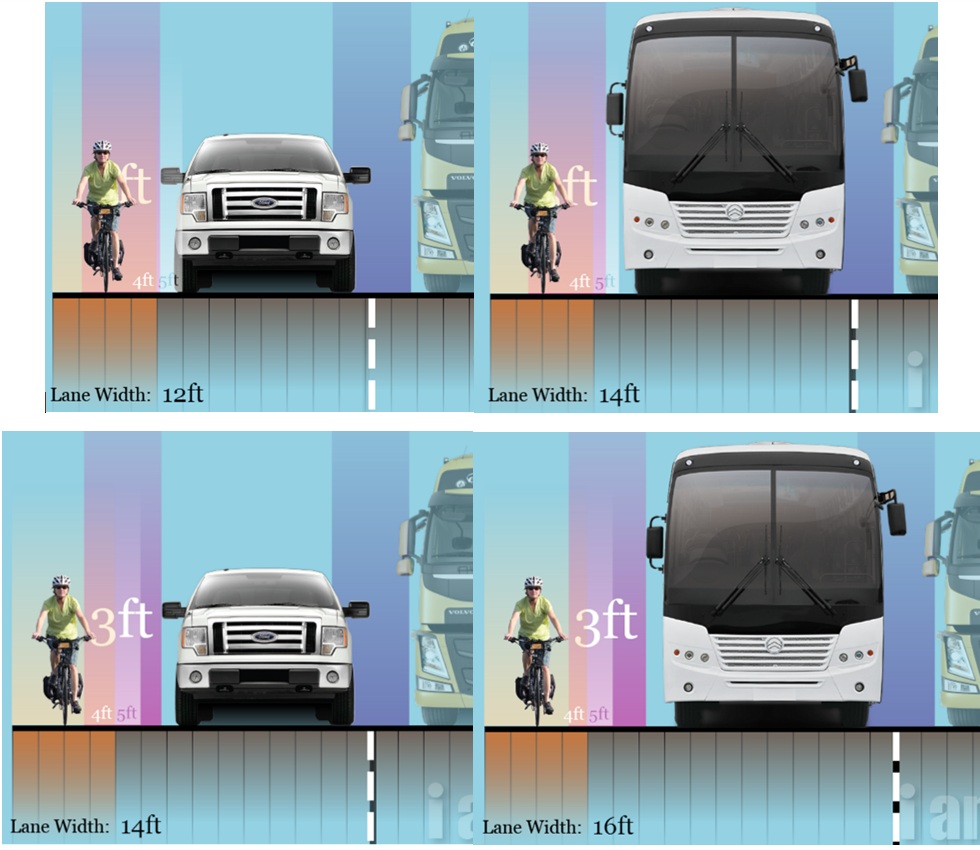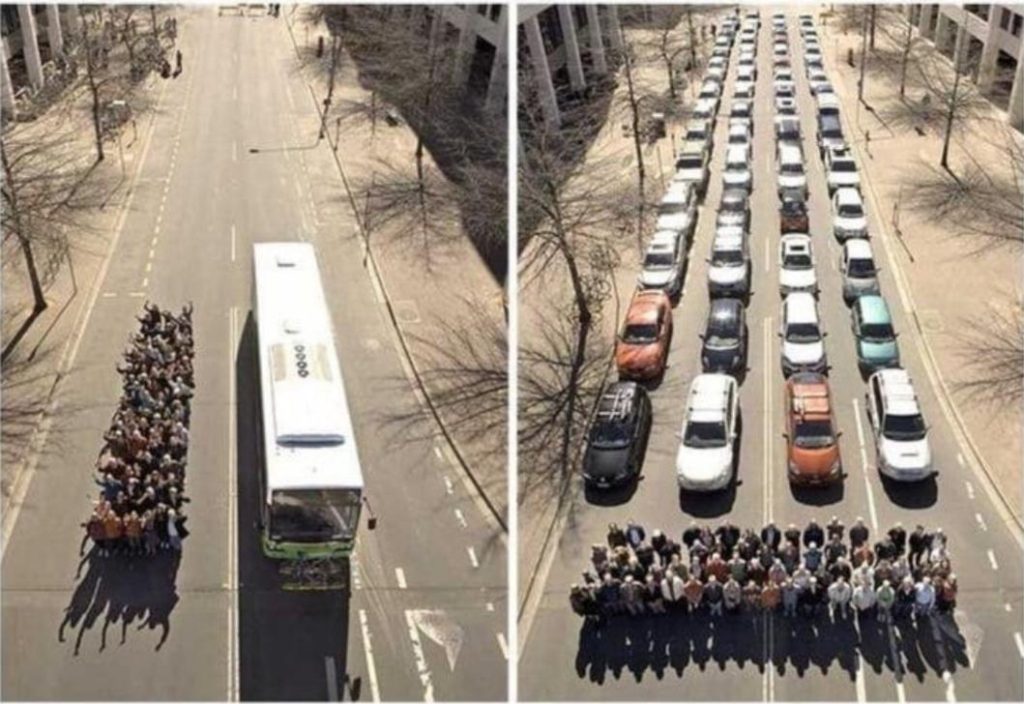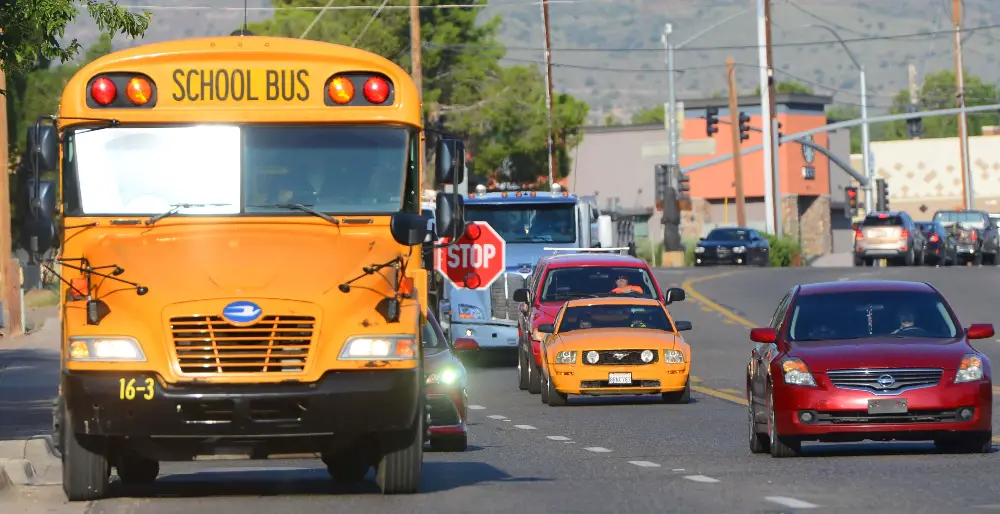The width distinction between buses (typically 95–105”) and cars (usually 65–75”) significantly shapes urban dynamics. Cars are agile, seat fewer, with lower air resistance; buses, though less maneuverable, offer higher capacity. Buses demand more parking space than cars due to their bigger width.
However, their respective functions and passenger capacities influence the width distinction between buses and cars. Buses are wider, accommodating more passengers for mass transit, while cars have narrower widths for maneuverability. This width variance impacts urban planning, traffic flow, and parking. It reflects their roles in transportation and urban dynamics.
What is the width of a bus?
A standard bus typically has a width ranging from 95 to 105 inches, approximately 8 to 9 feet. Articulated buses, consisting of two sections connected by a pivot, measure about 18 meters long, roughly 60 feet.
These dimensions vary based on design and regional standards. Buses offer efficient transportation, with widths optimizing passenger capacity, while articulated buses enhance maneuverability. These dimensions are vital for urban planning, accommodating traffic lanes and ensuring accessibility.
What is the width of a car?
The standard width of an average car is approximately 5.8 feet, according to VEHQ. However, car widths can vary due to aerodynamics and safety features. This dimension, around 70 inches, is a general guideline for typical vehicles.
It’s important to note that car designs and sizes can differ across manufacturers and models. This information impacts road infrastructure and parking space allocation, especially as vehicle sizes evolve.
How are the width of vehicles (Buses/cars) determined?

The width of vehicles, including buses and cars, is determined through design considerations, regulatory standards, and manufacturing processes. Let’s know below all the crucial factors that are determined:
1. Design Intent
Vehicle designers establish the width based on aesthetics, passenger comfort, and functionality. For cars, this involves considerations of interior space and market trends. On the other hand, buses cater to varying passenger capacities and specific usage scenarios.
2. Regulatory Standards
Both cars and buses are subject to safety regulations that dictate maximum allowable widths. In the United States, cars typically adhere to a maximum width of around 80 inches (6.67 feet), including mirrors.
Standard single-deck city buses, designed for urban roads, commonly have widths ranging from 100 to 102 inches (8.33 to 8.5 feet) to ensure safe navigation and compliance with road infrastructure.
3. Manufacturing Precision
During production, precise manufacturing techniques, including welding and assembly, ensure that vehicles achieve the intended width specified in their designs. This precision guarantees consistency and adherence to safety and performance standards for both cars and buses.
What does vehicle width calculation affect?
The width of vehicles has multifaceted effects on various aspects of transportation and urban development:
1. Road Design and Infrastructure
Wider vehicles require wider lanes, altering road construction and lane markings. For instance, a standard lane width accommodates cars at about 10 to 12 feet, whereas wider vehicles like buses may need lanes up to 14 feet wide. Narrower lanes, as wide as 9 feet, can contribute to congestion and reduced safety.
2. Parking and Space Allocation
Vehicle width plays a pivotal role in defining parking dimensions. Standard parking spaces, roughly 8.5 to 9 feet wide, accommodate most cars. However, larger vehicles, like SUVs, often require wider spots, up to 10.5 feet. In contrast, buses demand significantly wider areas, around 10 to 11.5 feet wide, impacting parking lot design and urban planning.
3. Traffic Congestion
Broad vehicles, like buses and wide trucks, can intensify congestion on constrained roads. On roads designed for cars, buses with widths around 8.5 to 9.5 feet or larger trucks occupying 10.5 to 11.5 feet contribute to reduced traffic flow, causing delays and disruptions.
4. Aerodynamics and Fuel Efficiency
Vehicle width shapes aerodynamics, impacting fuel efficiency. Wider vehicles encounter heightened air resistance due to larger frontal areas. For instance, a standard car’s width of around 6.5 feet experiences less resistance than wider buses, around 8.5 to 9.5 feet, leading to potential fuel economy reductions.
5. Maneuverability and Safety
Narrow vehicles, like compact cars around 5.8 feet wide, excel in navigating confined areas, ensuring agile maneuvering. In contrast, wider vehicles such as buses (8.5 to 9.5 feet) encounter challenges in tight spaces and have larger blind spots, impacting safety during turns and parking.
6. Public Transport Capacity
Wider buses, with widths of 8.5 to 9.5 feet, effectively accommodate more passengers, boosting public transport efficiency. This increased capacity reduces the number of vehicles needed, eases congestion, and enhances overall transit effectiveness.
Width of bus vs car- The comparison table
The width of vehicles significantly impacts their functionality and interactions within urban environments. Here’s a comprehensive comparison highlighting key factors that differentiate bus and car widths:
| Factor | Car Width Range (in feet) | Bus Width Range (in feet) |
| Average Width | 6.5 – 7.5 | 8.5 – 9.5 |
| Urban Maneuverability | Agile in tight spaces | Challenging, larger turns |
| Passenger Capacity | Usually up to 5 seats | Higher capacity |
| Aerodynamic Impact | Lower air resistance | Higher air resistance |
| Parking and Space Needs | Standard spaces suffice | Larger parking requirements |
How Do Buses Fit In The Same Lane As Cars?

Buses play a vital role in urban transportation, despite their size raising questions about lane sharing with cars. The answer lies in lane dimensions. While a school bus is larger than a car, lanes are designed wider than buses. Most buses can occupy around 90% of a lane’s width, compared to an average car utilizing about 60%.
Unlike cars, buses lack crumple zones, as their designs prioritize interior space for passengers instead of absorbing collision impacts. Their larger dimensions accommodate numerous passengers and contribute to efficient public transit. Despite these challenges, buses remain essential for sustainable city mobility, utilizing dedicated lanes and efficient routing to coexist with cars while offering substantial benefits.
FAQs
Is a van bigger than a bus?
No, a van is generally not bigger than a bus. Buses are larger vehicles designed to transport more passengers, while vans are typically smaller and used for transporting smaller groups of people or goods.
What is the maximum size of a bus?
The maximum length of a bus can vary depending on regulations and types. However, the government has increased the permissible length of normal buses to 13.5 meters (44.3 feet), potentially boosting seating capacity by 10-15%.
Why use the bus instead of the car?
Using buses instead of cars offers environmental benefits. Buses accommodate more passengers, reducing fuel consumption per person and lowering carbon emissions. This sustainable choice helps curb environmental impact, making bus travel an eco-friendly option for transportation.
What is the width of the bus in the US?
In the United States, city transit buses typically have a width of 8 feet 4 inches (2.55 meters). These buses are commonly used for short to medium-distance trips, offering an average length of 39 feet 2 inches (11.95 meters) and a capacity of approximately 29 seats with standing room for 76 passengers.
Final verdict
Understanding vehicle widths is crucial for designing efficient transportation systems and urban infrastructure. Buses and cars have distinct dimensions, which influence road design, parking space allocation, traffic flow, and environmental sustainability.
With their larger widths, buses offer the advantage of higher passenger capacity, reducing fuel consumption per person and curbing carbon emissions.
In contrast, cars, with their narrower widths, excel in maneuverability. Striking a balance between these considerations is essential for creating sustainable and accessible urban environments, accommodating diverse transportation needs, and minimizing environmental impact.










